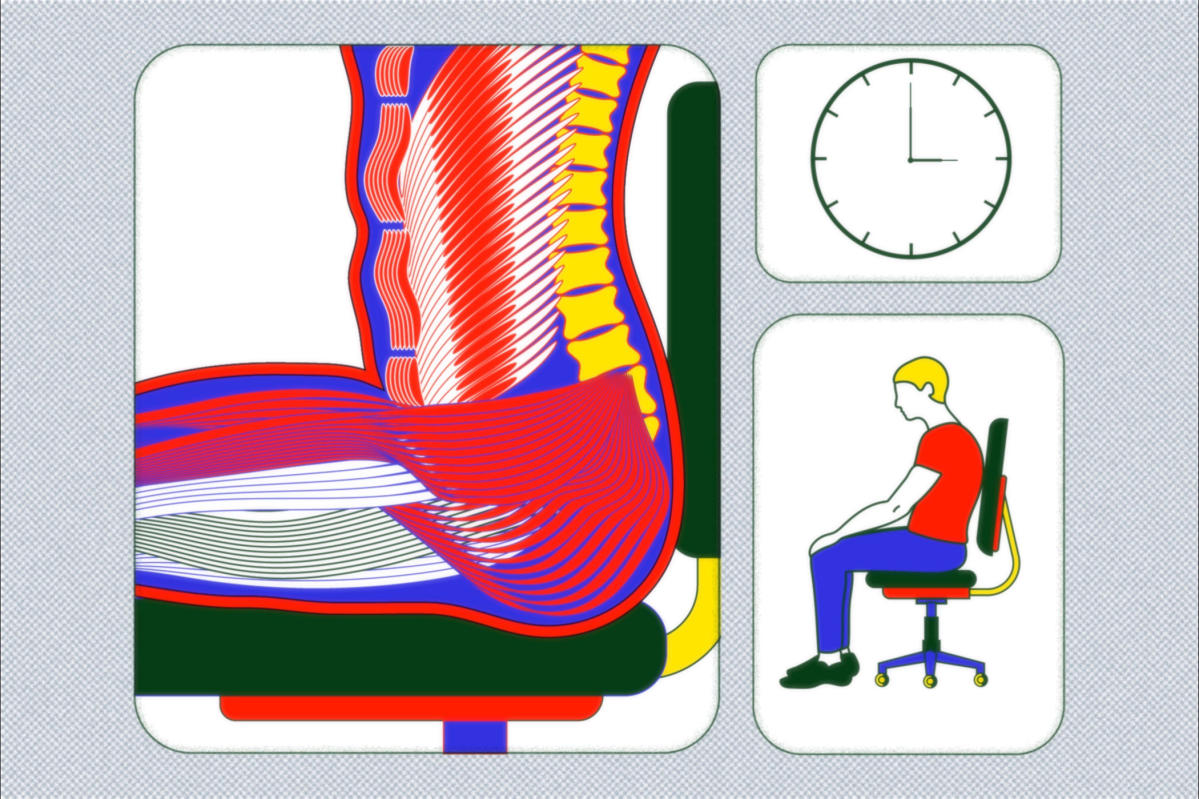After a long workday at your desk or hours in a car, it’s normal to feel a little stiff. It may just be that your hip flexors and lower back are tight. But you could also be experiencing a potentially debilitating condition called gluteal amnesia, or dead butt syndrome.
“The name sounds silly, but the side effects are serious,” said Jane Konidis, a specialist in physical medicine and rehabilitation at the Mayo Clinic in Rochester, Minnesota. “The gluteus maximus is one of the strongest muscles in the body and biggest shock absorbers,” she said. “If it’s not working properly, it can cause a domino chain of issues, from hamstring tears and sciatica to shin splints and arthritis in the knees.”
Gluteal amnesia happens when the muscles in your rear become so weak from inactivity they seem to forget how to function — meaning they fail or become slow to activate. This is different from a leg or arm “falling asleep” because of a compressed nerve; you won’t feel pins and needles. Some people may feel a dull ache while sitting, but most people don’t feel any pain until they go for a jog or hike.
Sign up for The Morning newsletter from the New York Times
Sluggish glutes can result in other muscles and joints, especially in the lower back and knees, picking up the slack, Konidis said. The pain can especially affect runners and rotational athletes, such as golfers and tennis players. (Tiger Woods has been forced to bow out of competitions because of the condition.)
Just like learning to engage your core, learning to fire the glutes can prevent this. But it doesn’t come naturally to most people, even those who have a strong butt. If you spend hours sitting, it’s important to learn to recognize when your glutes are turned off and how to get them working again.
What Causes the Butt to Shut Down
Your glutes are actually three muscles on the outside and back of your hips that stabilize the hip, lift the leg and rotate the thigh. Together, they act as a base to the spine, keeping the pelvis and core stable, Konidis said.
“If the glutes were really dead, we wouldn’t be able to stand,” she said.
When you take a step forward, the glutes should activate first. But when you sit, muscles on the front of the hip and thigh allow them to rest. Repeated eight-hour desk days can cause a delay in the neurons that signal them to activate, said Chris Kolba, a physical therapist at the Ohio State University Wexner Medical Center.
Over time, this cycle can cause the glutes to get weaker, which has been linked to lower back pain and knee pain, especially in active people.
How to Tell If You Have Gluteal Amnesia
When your biceps or quads activate, you can see them bulge. However, with the glutes, much like the core, it’s harder to spot, Konidis said. You might think your butt is strong because you can do 25 squats but your quads and lower back could be doing all the work.
Kolba said if you regularly sit for more than two to three hours at a stretch, you’ve probably experienced some degree of gluteal amnesia.
The simplest test is to stand on one leg, letting the other dangle. Your glute on the dangling side will feel soft. Now put weight on that leg and squeeze the cheek hard. You should feel a subtle firming of the muscle. If your glute is weak, you may need to squeeze a few times before you feel it fire, Konidis said.
For another test, try a glute bridge, in which you lay on your back and lift your hips into the air. When your hips are off the ground, consciously engage your cheeks. Do 5 to 10 reps. You should feel your glutes burn a little. If you don’t, but feel extreme strain in your hamstrings (the muscles in your leg just below your butt), that’s a sign your glutes aren’t activated, Kolba said.
How to Turn On Your Glutes
For most healthy people, the glutes should fire on their own when moving. Set an alarm and stand up every 30 to 50 minutes and gently tap your butt cheeks with your fingertips, Konidis said. “That little bit of stimulation reminds the brain that those muscles are there,” she added.
Even better, march in place or do some hip circles or squats, making sure to tighten your butt cheeks each rep.
Simple exercises can help turn on reluctant glutes. This is especially important before you work out or play a sport, said Jordan Metzl, a sports medicine physician at Hospital for Special Surgery in New York City and the author of “Running Strong.”
Exercises such as clamshells, hip thrusts, side planks, split squats and single-leg glute bridges don’t require equipment and can be performed at home. Pick two or three every other day and do them in a controlled manner slowly until you feel a slight burn in the glutes.
If you walk or run regularly, don’t assume your glutes are strong. Add in exercises like squats or lunges at least a few times a week, Metzl said.
If you consistently work your glutes but your butt never feels tired and you experience pain while doing activities such as running, seek help from a sports medicine physician or physical therapist, Konidis said.
“When one link in the chain is weak, the whole fence collapses,” she said. “And the glutes should be your strongest link.”
c.2024 The New York Times Company
